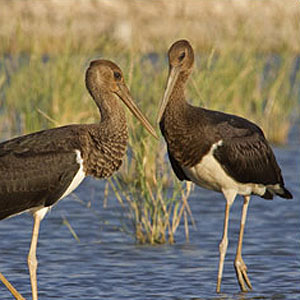Magazine | Études
L’activité humaine influence la répartition des Cigognes noires qui hivernent en Afrique

Cigognes noires (Ciconia nigra) juvéniles dans un site de migration dans le nord d’Israël.Photographie : Thomas Krumenacker
Introduction
Des biologistes français et luxembourgeois de de différents organismes (IRD, universités de Strasbourg et de Montpellier, ONF, Société Parcelles et Plygnes, Lëtzebuerger Natur-a Vulleschutzliga et Société GéoHyd) ont étudié l’impact des activités humaines sur la répartition de cigognes en suivant sept oiseaux par satellite de 1998 à 2006 et en étudiant une population de cigognes entre 2003 et 2005 dans le ranch de Nazinga (Burkina Faso) et au Ghana.
Ces chercheurs ont constaté notamment que les juvéniles occupaient de plus vastes domaines que les adultes et les sub-adultes, et que la présence de rivières pérennes (permanentes) et d’activités humaines influençait grandement leur répartition.
Abstract
Biologists from France and Luxemburg have investigated the impact of human activity and habitat characteristics on the distribution of Black Storks Ciconia nigra on wintering grounds in West Africa.
Seasonal variations in wintering home-range size and habitat selection of seven Black Storks were studied using satellite tracking from 1998 to 2006. A Black Stork population was followed in the field from 2003 to 2005 in the Nazinga Game Ranch (Burkina Faso) and Ghana.
The results were that adults and sub adults have smaller mean global ranges than juveniles and smaller mean core ranges, suggesting that juveniles prospect widely for suitable habitats during their first winter period.
In all birds the home range becomes increasingly fragmented from November to February. Two main factors seem to be involved in this fragmentation: Black Storks seem to prefer locations on perennial rivers but many rivers in this region gradually dry out into separated pools at this time of year; and monthly variation of human activity along the rivers. Occurrence of Black Storks is inversely proportional to human activity, irrelevant of whether open habitat is available at the location. When human pressure is moderate, open habitats and low tree canopy favour the presence of Black Storks.
The biologists propose that conservation measures should include the creation of reserves located along perennial rivers, away from areas of human activity.
Poursuivez la lecture de cet article, en vous abonnant dès maintenant !
Découvrez les Archives d’Ornithomedia.com
Pour seulement 10,00 €TTC/an (ou 6,00 € les 6 mois)
Profitez de plusieurs centaines d’articles en accès illimité et sans aucun engagement.
Compléments
Les observations sur Ornithomedia.com
Cigognes noires (Ciconia nigra)
Dans la galerie photos d’Ornithomedia.com
Cigognes noires (Ciconia nigra)
À lire sur le web
L’article de Thomas Krumenacker montrant de nombreuses photos de Cigognes noires en halte migratoire dans le nord d’Israël
Ouvrages recommandés
- La Cigogne noire de Gérard Jadoul
- Le guide Ornitho de Killian Mullarney
- Migration des cigognes noires de Gérard Jadoul
- Aux pays des cigognes noires de Croquis et Aquarelles. Alan Johnston
Sources
- Chevallier Damien, Le Maho Yvon, Baillon Francois, Duponnois Robin, Dieulin Claudine, Brossault Paul, De Franclieu Philippe, Lorge Patric, Aurouet Axel et Massemin Sylvie (2010)
- Human activity and the drying up of rivers determine abundance and spatial distribution of Black Storks Ciconia nigra on their wintering grounds. Bird Study, 57: 3, pages 369 – 380.
- Informaworld.com





Aucun commentaire sur ce sujet
Participer à la discussion !